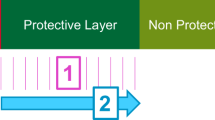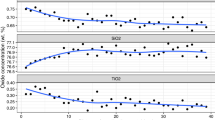Abstract
Short and long-term geochemical interactions of R7T7 nuclear glass with water at 100°C were simulated with the DISSOL thermokinetic computer code. Both the dissolved glass quantity and the resulting water composition, saturation states and mineral quantities produced were calculated as a function of time. The rate equation used in the simulation was first proposed by Aagaard and Hegelson: v = k+•S•a(H+)-n•(1–e-(A/RT)). It simulates a gradually diminishing dissolution rate as the reaction affinity diminishes. The best agreement with 1-year experimental data was obtained with a reaction affinity calculated from silica activity (Grambow’s hypothesis) rather than taking into account the activity of all the glass components as proposed by Jantzen and Plodinec. The concept of residual affinity was introduced by Grambow to express the fact that the glass dissolution rate does not cease. We prefer to replace the term “residual affinity” by “contextual affinity”, which expresses the influence on the dissolution rate of three factors: the solution chemistry, the metastability of SiO2(m), and the possible precipitation of certain aluminosilicates such as zeolites.
Similar content being viewed by others
References
P. Aagaard and H.C. Hegelson, Am. J. of Sci. 282, 237–285 (1982).
H.C. Hegelson, W.M. Murphy and P. Aagaard, Geoch. Cosmoch. Acta, 48, 2405–2432 (1984).
A.C. Lasaga, J. Geo. Res. 81B6, 4009–4025 (1984.
B. Grambow, in Scientific Basis for Nuclear Waste Management VIII, (Mater. Res. Soc. Proc.) 44, 15–27 (1984).
B. Grambow, SKB Technical Report 87–02 (1987).
E. Vernaz, T. Advocat and J.L. Dussossoy, presented at the 4th International Symposium on Ceramics in Nuclear Waste Management (91st Am. Ceram. Soc. Meeting, 1989).
B. Grambow and D.M. Strachan, in Scientific Basis for Nuclear Waste Management XI, (Mater. Res. Soc. Proc.) 112, 713–724 (1988).
L.R. Pederson, C.Q. Buckwalter, G.L. McVay, R. Riddle, in Scientific Basis for Nuclear Waste Management VI, (Mater. Res. Soc. Proc.) 15, 47–54 (1982).
R. Haaker, J. Malow and P. Offermann. in Scientific Basis for Nuclear Waste Management VIII, (Mater. Res. Soc. Proc.) 44, 121–128 (1985).
P. Van Iseghem and B. Grambow, in Scientific Basis for Nuclear Waste Management XI, (Mater. Res. Soc. Proc.) 112, 631–639 (1988).
N. Godon and E. Vernaz, in Scientific Basis for Nuclear Waste Management (this volume) (Mater. Res. Soc. Proc.).
A. Paul, J. Mat. Sci., 12, 2246–2268 (1977).
C.M. Jantzen and M.J. Plodinec, J. Non Cry. Sol., 67, 207–223 (1984).
S. Fillet, PhD Thesis: University of Montpellier, France (1987).
B. Fritz, Sci. Geol. Mem., 65, (1981).
Y. Tardy and B. Fritz, Clays Minerals, 16, 361–373 (1981).
J.L. Crovisier, T. Advocat, J.C. Petit and B. Fritz, in Scientific Basis for Nuclear Waste Management XII, (Mater. Res. Soc. Proc.) 127, 57–64 (1989).
W.L. Bourcier, K.G. Knauss and C.I. Merzbacher, presented at 4th International Symposium on Ceramics in Nuclear Waste Management (91st Am. Ceram. Soc. Meeting, 1989).
H.C. Hegelson, J.M. Delany, H.W. Nesbitt and D.K. Bird, Am. J. Sci, 274, 1089–1198 (1978).
Author information
Authors and Affiliations
Rights and permissions
About this article
Cite this article
Advocat, T., Crovisier, J.L., Fritz, B. et al. Thermokinetic Model of Borosilicate Glass Dissolution: Contextual Affinity. MRS Online Proceedings Library 176, 241 (1989). https://doi.org/10.1557/PROC-176-241
Published:
DOI: https://doi.org/10.1557/PROC-176-241




